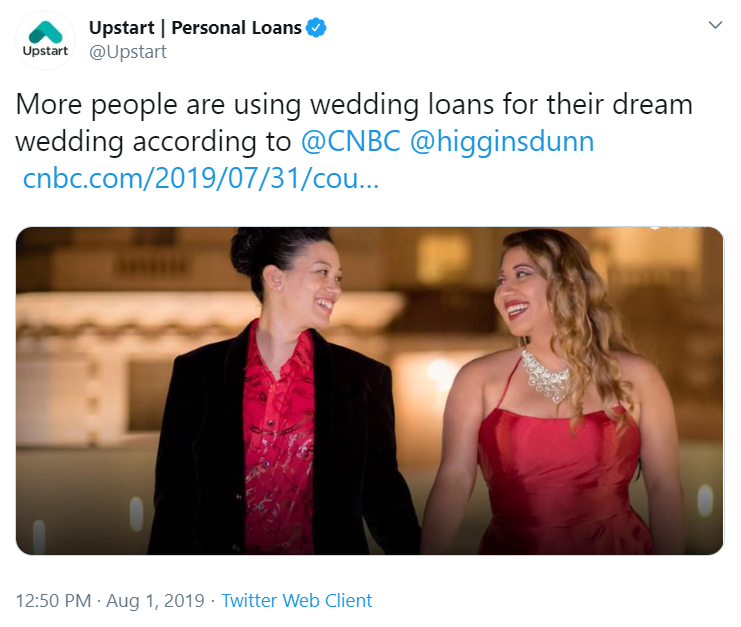Consumers say “yes” to wedding loans
Increasingly lavish and Instagrammable weddings are driving activity for wedding-related personal loans and wedding insurance. Financial services companies and insurers pitch these products with plenty of wedding imagery in paid social and digital ads, owned social posts and content marketing. These messages could appeal to consumers who are intent on spending big on their weddings but don’t have the cash to do so and know they’ll end up borrowing one way or another. Lenders can further capitalize on that mindset, reeling in customers with promises of the perfect wedding at an affordable cost.
Personal loans
Demand for wedding loans quadrupled between 2018 and 2019, according to David Green, chief product officer at online lender Earnest. That’s in part thanks to social media: Consumers heavily document weddings on various channels, driving people to find new ways to stand out (think doughnut walls, custom calligraphy and more). That can come at a high cost—and a cost no longer by default borne by the bride’s family. So the turn to personal loans makes sense as Millennials look for a way to finance their Instagrammable ceremonies and parties.
To sell these loans effectively, companies first have to make sure consumers understood that personal loans can be used for something besides consolidating credit card debt. Lenders turn to content marketing to teach consumers that the product is versatile and well-suited for many big expenses—including weddings.
Brands target Millennials on social media, where they are already looking for buying advice and wedding inspiration. The channel is ideal for promoting products related to something as personal as a wedding as it lends brands an air of empathy.
It’s also ideal because of who’s using social media and who’s getting married: In the US, on average, women get married at age 28 and men at age 30. Those ages fall right in the demographic most likely to be doing research online before making purchases. So it makes sense for lenders to prioritize owned social to promote personal loans for weddings.
Content marketing is especially prevalent on social media, where companies direct consumers to information on their own sites. For example, SoFi, in partnership with Zola, offers a range of couple-targeted financial tools via Instagram. And Marcus‘ website features YouTube videos highlighting the benefits of using a personal loan to pay for a wedding. The video compares credit card promotional periods with personal loan fixed rates and highlighted the benefits of being able to pay over time. That comprehensive approach could hook couples looking to manage finances in a single place.
Other lenders similarly use partnerships to promote wedding-related content that, in turn, promote personal loans. For example, Upstart promotes affiliates—such as The Knot, a popular wedding planning website, and CNBC—supporting its value proposition of giving consumers the cash they need for blowout celebrations. Linking to objective, third-party sources makes the company’s self-promotion feel informative rather than salesy.
What we think

Lenders should borrow from broader promotions for personal loans, where they tend to focus on simplicity. That messaging could extend to wedding loans, as stressed-out couples seek ways to make both the planning and financing processes more manageable.
Given the push for unique, social media-worthy weddings, lenders should also mix up the imagery in their creatives, showing more weddings that are offbeat but still recognizable enough to fit in on Instagram.
What’s more, they should also mix up the characters in the creatives. Younger consumers are evolving and reinventing the status-quo, as we’ve seen in Mintel’s 2019 Global Consumer Trend ‘Redefining Adulthood.’ Brands need to examine consumers’ cultural values in order to demonstrate their openness to all consumers and resonate with a larger audience.
Insurance
As weddings are becoming increasingly expensive, consumers are seeking products that will help ease some of their planning stress. Although wedding insurance can’t protect customers against all wedding-related disasters, it can ensure that property damage, injury, sudden illness and lost rings are covered.
That’s especially important given trends in wedding timing. Americans are now waiting longer to get married and have kids, which means that when they reach these milestones they may be inclined to celebrate in a big way, according to Mintel research on party planning and home entertaining. According to Mintel research on marketing to Millennials, this demographic is likely to get married at around 30 years old—which means Millennials, yet again, present themselves as the key demographic for wedding insurance. The best way for insurers to reach their target audience is through social media, as consumers age 18-24 and 25-34 are most likely to use social media to research brands and products.
However, many consumers are still unaware that wedding insurance is, in fact, a product. Insurers have to merge celebration with realism in their marketing strategies to help consumers understand the potential risks that come along with such a big event. Calling out real-life examples of wedding disasters helps insurers give planners something tangible to worry about, solidifying consumers’ need for coverage. Travelers Insurance, for instance, calls attention to the wedding claims it paid in 2018, citing, 41% for vendor issuers and 22% for property damage, again emphasizing the need for insurance. Travelers also differentiates itself from competitors by partnering with well-known brands and publications. For instance, the insurer partners with The Knot to provide customers the opportunity to win $10,000 for their wedding, while also informing them about insurance.
Allstate, on the other hand, takes the social media approach to make light of common wedding disasters, using #WeddingsAreMayhem, featuring its beloved Mayhem character.
What we think
Insurers should be looking to strategic partnerships and informational content marketing on social media to really emphasize the need for its wedding insurance product. Partnering with other well-known wedding websites and publications help drive product awareness to consumers and help position their products as recommended.
Authors:


![[Part 1] Canada vs US Telecom: Mobility](https://welcome.comperemedia.com/wp-content/uploads/2020/03/CM_CanadaVsTelecomPart1_DeepPurple300_v1.2_Blog_2000x1000.jpg)
